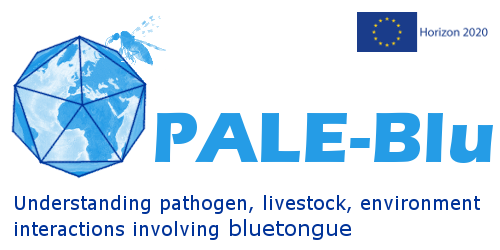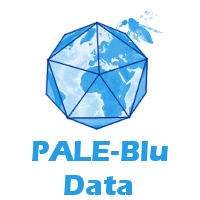Aims and objectives
PALE-Blu will investigate interactions between bluetongue virus, its ruminant hosts and insect vectors that are relevant to the European ecosystem. The project will focus on genetic and environmental factors (including the distribution of different insect species and populations) that can influence virus replication and transmission, and therefore the incidence, spread and control of different BTV strains in different regions. It will also explore the basis for improved control strategies, including better models of disease spread, better diagnostic assays, antivirals and vaccines.
The objectives of the project are:
Objective 1: Develop a more detailed and up-to-date molecular-epidemiology map of BTV strains circulating in domesticated and wild ruminants in Europe and neighbouring countries: This will include Northern, Central and Mediterranean Europe, as well as other ‘source’ regions containing outbreak strains that continue to spread to and emerge in Europe (e.g. Turkey, Israel, sub-Saharan, Northern and Western Africa). The project will also provide data concerning the evolution and emergence of novel BTV reassortants / genotypes.
Objective 2: Map interactions between the environment, the composition of the Culicoides species community, the genetic characteristics of Culicoides populations and their microbiomes, to quantify connectivity between midges and virus sub-populations: This will help to disentangle the relative effects of environmental and anthropogenic factors in BTV spread, to quantify connectivity between epi-zones over short time periods and large areas.
Objective 3: Develop innovative multiplex diagnostic tools for BTV identification and typing: This will enhance surveillance strategies, increasing specificity and sensitivity (particularly for the detection and identification of co-circulating serotypes) and reduce overall assay costs.
Objective 4: Characterise orbivirus-related genetic control of infection and horizontal transmission in vertebrate hosts, as well as infection, replication and vector competence in European Culicoides spp.: This will include the development of cell lines derived from different European Culicoides vector species. These cells and adults of the different vector species will be used to identify the viral genes and proteins and the molecular mechanisms that restrict or enhance horizontal and/or vector transmission of different BTV strains. The project will also explore the significance of Culicoides saliva proteins in the infection, transmission and immune responses to BTV within the vertebrate host. We will also determine how the innate immune response of ruminants, controls virulent and less virulent strains/serotypes of BTV in the presence or absence of the Culicoides saliva.
Objective 5: Develop novel BT vaccines, vaccination strategies and antiviral approaches for BTV: This objective will explore cross reactivity between serotypes and topotypes, using new generation recombinant antibody methods and epitope mapping. BTV antigens/epitopes stimulating neutralising antibody and cellmediated immunity will be expressed yeast and in viral vectored and Disabled Infectious Single Animal (DISA) vaccine strategies. The efficacy of compounds that have recently been identified with potential antiviral activities will be further evaluated, particularly for use in combination with vaccines.
Objective 6: Establish a comprehensive communication strategy: Work package 12 will establish effective communication between consortium partners, relevant stakeholders and the lay public. A communication strategy will be developed to incorporate and combine tested methodologies and innovative solutions to ensure effective communication initiatives, balanced and collaborative contributions by project partners, and achievement of project goals. Dissemination will be an important part of the communication strategy. Measurable indicators will facilitate monitoring, and a specific risk-management approach will help to prevent or mitigate problems.
The PALE-Blu project has twelve work packages designed to ensure the above objectives are met in an efficient manner.




